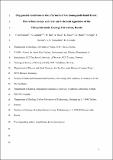Files in this item
Oxygenated conditions in the aftermath of the Lomagundi-Jatuli Event : the carbon isotope and rare earth element signatures of the Paleoproterozoic Zaonega Formation, Russia
Item metadata
| dc.contributor.author | Kreitsmann, T. | |
| dc.contributor.author | Lepland, A. | |
| dc.contributor.author | Bau, M. | |
| dc.contributor.author | Prave, A. | |
| dc.contributor.author | Paiste, K. | |
| dc.contributor.author | Mänd, K. | |
| dc.contributor.author | Sepp, H. | |
| dc.contributor.author | Martma, T. | |
| dc.contributor.author | Romashkin, A.E. | |
| dc.contributor.author | Kirsimäe, K. | |
| dc.date.accessioned | 2021-07-08T23:37:58Z | |
| dc.date.available | 2021-07-08T23:37:58Z | |
| dc.date.issued | 2020-09 | |
| dc.identifier | 269173018 | |
| dc.identifier | 8bbe1215-734c-415b-9edf-d35c161420f5 | |
| dc.identifier | 85088655269 | |
| dc.identifier | 000561218200012 | |
| dc.identifier.citation | Kreitsmann , T , Lepland , A , Bau , M , Prave , A , Paiste , K , Mänd , K , Sepp , H , Martma , T , Romashkin , A E & Kirsimäe , K 2020 , ' Oxygenated conditions in the aftermath of the Lomagundi-Jatuli Event : the carbon isotope and rare earth element signatures of the Paleoproterozoic Zaonega Formation, Russia ' , Precambrian Research , vol. 347 , 105855 . https://doi.org/10.1016/j.precamres.2020.105855 | en |
| dc.identifier.issn | 0301-9268 | |
| dc.identifier.other | RIS: urn:06F8080F856E1C35FF37877ABE6060BB | |
| dc.identifier.other | ORCID: /0000-0002-4614-3774/work/77524517 | |
| dc.identifier.uri | https://hdl.handle.net/10023/23503 | |
| dc.description | This study was supported by Estonian Research Council project PRG447, and the Estonian Centre of Analytical Chemistry. K.P. and A.L. were supported by the Research Council of Norway through its Centres of Excellence funding scheme grant No. 223259. K.P. acknowledges the Estonian Research Council grant MOBJD542 and T.M. PUT611. | en |
| dc.description.abstract | The c. 2.0 Ga Zaonega Formation of the Onega Basin (NW Russia) has been central in efforts to understand what led to the initial rise (Great Oxidation Event, GOE) and postulated fall in free atmospheric oxygen and associated high-amplitude carbon cycle excursions, the Lomagundi-Jatuli Event (LJE) and subsequent Shunga Event during Paleoproterozoic time. The Formation accumulated shortly after the LJE and encompasses both the recovery in the carbon cycle and hypothesised contraction of the oceanic oxidant pool. However, interpreting the correct environmental context recorded by geochemical signatures in the Zaonega rocks is difficult due to a complex depositional and diagenetic history. In order to robustly constrain that history, we undertook a multiproxy study (mineralogy, petrography, carbon isotope and rare earth element composition) of carbonate beds in the upper part of the Zaonega Formation recovered in the 102-m composite section of the OnZap drill-cores. Our findings differentiate primary environmental signatures from secondary overprinting and show that: (i) the best-preserved carbonate beds define an upwards increasing δ13Ccarb trend from c. -5.4‰ to near 0‰; and that (ii) large intra-bed δ13Ccarb variations reflect varying contributions of methanotrophic dissolved inorganic carbon (DIC) to the basinal DIC pool. Rare earth element and yttrium (REYSN) patterns confirm a marine origin of the carbonate beds whereas a consistent positive EuSN anomaly suggests a strong high temperature hydrothermal input during accumulation of the Zaonega Formation. Importantly, the presence of a negative CeSN anomaly in the REYSN pattern indicates an oxygenated atmosphere-ocean system shortly after the LJE and indicates that models invoking a fall in oxygen at that time require reassessment. | |
| dc.format.extent | 16 | |
| dc.format.extent | 4769438 | |
| dc.language.iso | eng | |
| dc.relation.ispartof | Precambrian Research | en |
| dc.subject | Carbon isotopes | en |
| dc.subject | Rare earth elements | en |
| dc.subject | Lomagundi-Jatuli Event | en |
| dc.subject | Ce anomaly | en |
| dc.subject | Zaonega Formationˇ | en |
| dc.subject | QE Geology | en |
| dc.subject | NDAS | en |
| dc.subject | SDG 14 - Life Below Water | en |
| dc.subject.lcc | QE | en |
| dc.title | Oxygenated conditions in the aftermath of the Lomagundi-Jatuli Event : the carbon isotope and rare earth element signatures of the Paleoproterozoic Zaonega Formation, Russia | en |
| dc.type | Journal article | en |
| dc.contributor.institution | University of St Andrews. School of Earth & Environmental Sciences | en |
| dc.contributor.institution | University of St Andrews. Scottish Oceans Institute | en |
| dc.contributor.institution | University of St Andrews. St Andrews Sustainability Institute | en |
| dc.contributor.institution | University of St Andrews. St Andrews Isotope Geochemistry | en |
| dc.contributor.institution | University of St Andrews. Marine Alliance for Science & Technology Scotland | en |
| dc.identifier.doi | 10.1016/j.precamres.2020.105855 | |
| dc.description.status | Peer reviewed | en |
| dc.date.embargoedUntil | 2021-07-09 |
This item appears in the following Collection(s)
Items in the St Andrews Research Repository are protected by copyright, with all rights reserved, unless otherwise indicated.

